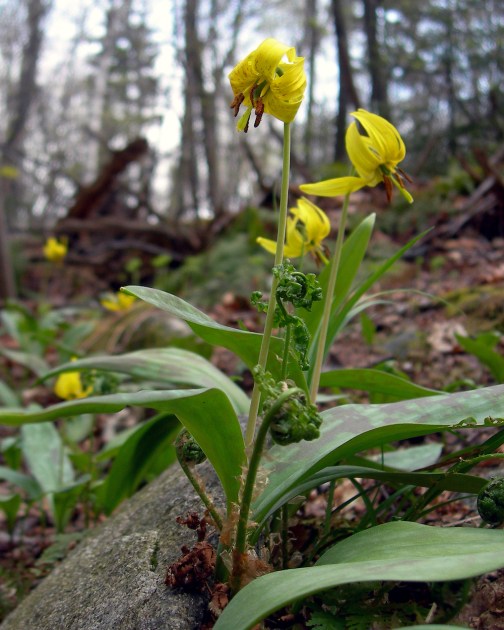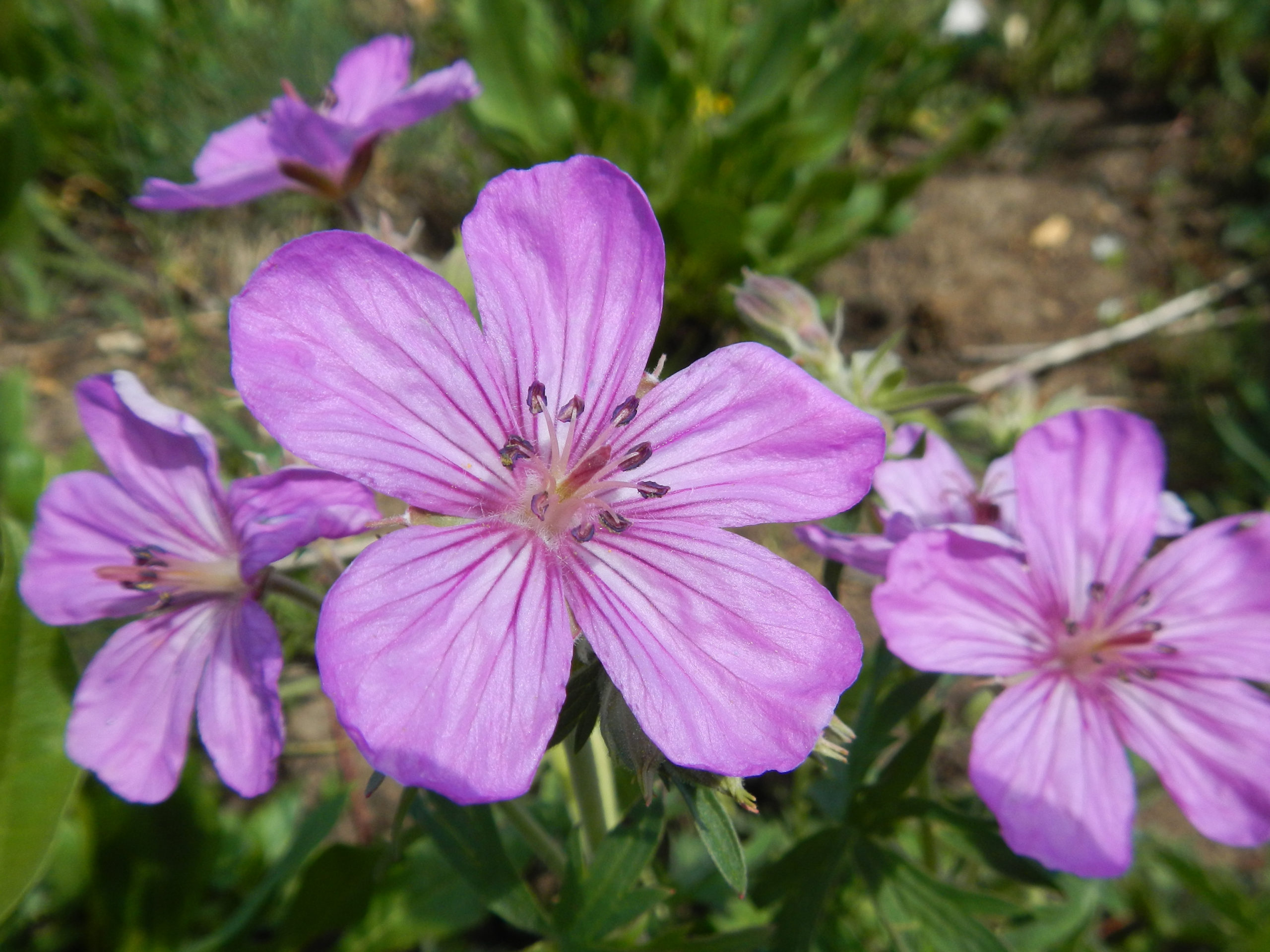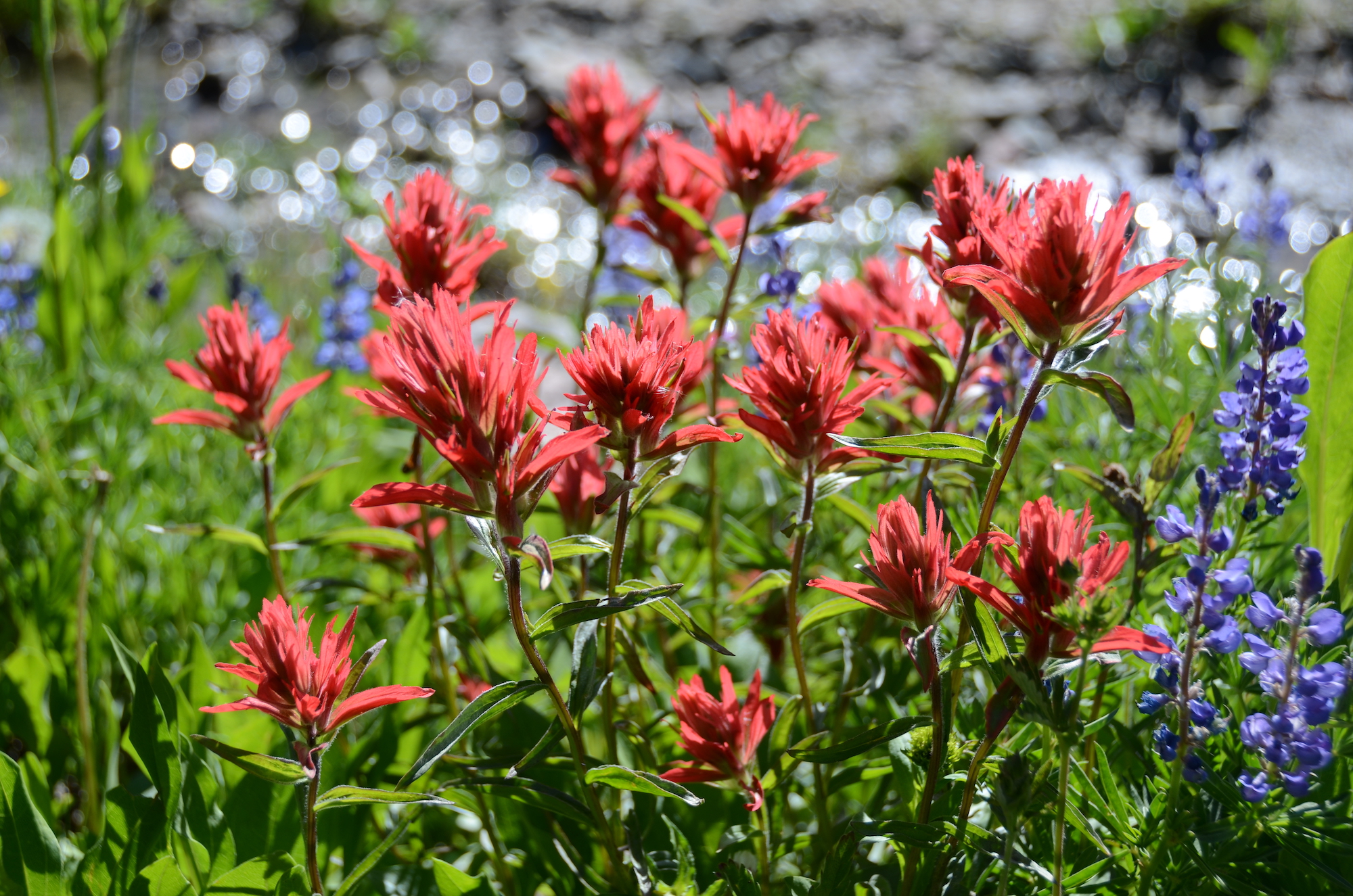As a nature photographer, I can’t resist photographing a beautiful blossom. Sometimes a single, delicate bloom, no bigger than my pinky nail peeks at me from the forest floor. Other times, a multi-colored, multi-species garden greets me as I crest a mountain pass.
But my passion for wildflowers stems from more than simply them being eye candy. Lately, with so much anxiety in the air, I’m even more grateful than usual that spring, with its plethora of budding plants, is here.
Trout Lilies
One of the first wildflowers to emerge each spring is the trout lily. Early spring is often a schizophrenic mix of bluebird skies and dreary days. My mood is, too, but as the snow melts, trout lilies appear on the forest floor, a sign of renewed life among last autumn’s dead, dull leaves.

Native to the eastern and central U.S., trout lilies are so named because their narrow, mottled leaves, which can be up to six inches long, resemble a trout. A perennial sprouting from a corm (bulb), it quickly blooms and produces seeds, racing to beat the leaves on the trees that block the sun.
Trout lilies create colonies by spreading runners, called stolens. Though it takes six to seven years for an individual plant to mature and make a single one- to two-inch yellow flower, a colony can carpet the ground with a profusion of cheerful blossoms.
New trout lilies propagate from seeds, too, which are dispersed by ants. In this symbiotic relationship, ants are attracted to an appendage on the trout lily’s seed, called an eliaosome, which is rich is lipids and protein. Ants carry the seeds underground where their larvae feed on the eliaosome. The seed is ant trash, which suits the seed, as its now in a perfect place to germinate.
I photographed my first trout lily in 2007 while working on a guidebook, Hiking the Green Mountains, in Vermont. On my first hike that spring, up Harmon Hill near Bennington, the profusion of blooming trout lilies saved what would otherwise have been the drabbest hike in the book.
Nutrition or Poison?
Most of my wildflower sightings are hikes into the backcountry, either to reach a mountaintop or a remote trout-filled tarn. I’m usually chasing my uber-fit husband or 23-year-old son. I admit I often pause to take photos of wildflowers as a chance to get my heart out of my ears.

A trailside wood sorrel literally helps me catch my breath as much as its delicate beauty figuratively takes my breath away. Wood sorrel is edible, too. When my son was younger, it was the only vegetable I could get him to eat, due to the novelty of harvesting it while we hiked.
Some wild beauties are not delicacies; they’re deadly. You may have heard of poison hemlock, the plant that killed Socrates. There are many others. Once while trekking in the Cordillera Blanca region of the Peruvian Andes, documenting wildflowers, I came across a clump of nightshade.
This herbaceous perennial, related to the such common vegetables as tomatoes, potatoes, and eggplant, is highly toxic to humans, as is deathcamas, a grass-like plant, mainly in the western part of the U.S., that sends up stalks with pretty white-yellow clusters on top. Its name is a dead give-away, though mostly for livestock that accidentally ingest it while grazing.
Lessons on Location
Wildflowers continue to surprise and educate me when I travel. For example, 15 years ago, while sipping tea on a rooftop café in Ethiopia, a flowering tree caught my eye. It was bushy and three stories high. Upon closer examination, I realized it was a poinsettia, which was native there and blooming even though it wasn’t Christmastime.

Poinsettias need equal hours of daylight and darkness to bloom, which they get naturally near the equator in Ethiopia. Seeing other flowering plants that are nursery-grown in America, but wild in other parts of the world, has made me appreciate the wild ones even more.
My favorite place to photograph wildflowers is in the alpine zone, where I’m always awed by how such fleeting, fragile flowers, which can’t tolerate a footstep, survive in Arctic-like wind and temperatures.
While climbing Kilimanjaro, small clumps of yellow wildflowers smiled at me below the basalt boulders in the otherwise barren moonscape at 16,000 feet.
Another time, while resting on a rock in the Absaroka-Beartooth Wilderness in Wyoming, I looked down to see a tiny shooting star, which is a type of alpine primrose. Only buzz-pollinators, like bumblebees, can gather its pollen, which clings tightly to its anthers.
On that same hike, I laughed out loud when I saw my first elephanthead lousewort, which looked like dozens of fuchsia elephant heads stacked on each other, trunks reaching into the air.
Photographer’s Challenge
Part of the challenge of photographing each specimen is to make the image more compelling than a snapshot. Can I make a sticky geranium look sticky? Can I make the showy Lewis Monkeyflower, that grows near mountain streams, look moist and vibrant? I often use a macro-lens to get super close, especially if the bloom is tiny.
When I shoot into the center of a flower, I learn its personality. The depth of its soul is revealed, as a living thing. “Shy” flowers are tough to get in focus. Like people, some wildflowers let you see inside easier than others.
Take the mountain harebell that’s common throughout the Rocky Mountains. For a long time, it always looked white instead of blue in my photos, and it would never give my camera a clear look into its little bell. I was so delighted when I finally got it right!
Wildflowers are indeed a welcome distraction in many ways. Their bright colors bring joy to the heart. Their perennial dependability is a comfort in an unpredictable era. With more time at home, why not use some of it to smell the wild roses, or whatever might be blooming right now?









During the pandemic stay at home, I’ve been seeking solace in Nature and am lucky to live on a 5-acre mix of meadows and forests. I’ve gotten up close and personal with the wildflowers and the lichen and the bugs and put my iPhone camera to hard use getting those pictures that show me the details. Your photography adventures spoke volumes to me and made me feel we are kindred spirits. Thanks for your lovely chronicle. Lori in Bellville, Texas
Thanks, Lori. You made my day with your kind reply. Glad to find another fan of wildflowers!